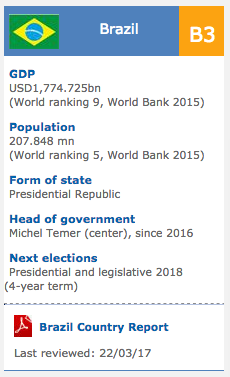Unfavorable economic structure
The structure of the Armenian economy is unfavorable. In 2014, agriculture accounted for about 22% of GDP (up from a low of 18% in 2008), services for 48%, construction for 11%, mining and utilities for 8%, and manufacturing for just 11% (see Figure 2).
Industrial production and exports are narrowly based on commodities, foodstuff and simple products, which makes the economy highly vulnerable to shifts in global prices for these goods. In 2014, commodities (mostly metals) accounted for 74% of total Armenian merchandise exports.
In terms of markets, Russia is the key trade partner, accounting for 20% of Armenian exports and 24% of imports, adding further vulnerability to the Russian business cycle.
Moreover, Russia is an important source of remittances for Armenia. Remittances from Russia stood at USD1.6bn in 2013 (before the Russian crisis) accounting for 14% of Armenian GDP. However, they have dropped to USD0.7bn or 6% of GDP in 2015 (see also Figure 4).
Subdued economic growth
After double-digit real GDP growth rates in 2002-2007 (annual average +13.4%) thanks to the commodity price boom, falling commodity prices combined with the end of a construction boom and sharply reduced external demand in the wake of the global economic crisis caused growth to slow rapidly and to shift to GDP contraction of -14.2% in 2009. Following a short-lived recovery with growth reaching +7.1% in 2012, growth has faltered again since 2013 as a result of the renewed fall in global commodity prices and the crisis in Russia (see Figure 3).
In full-year 2015 the economy expanded by +3%, followed by +4.5% y/y in Q1 2016 and +1.5% y/y in Q2 2016 (volatility partly due to base effects). We forecast full-year growth of +2.2% in 2016 and +2.5% in 2017. In the next few years, annual growth is likely to remain subdued (around +3%) as global commodity prices as well as the Russian economy are expected to remain under pressure. This is too low for a frontier market to catch up substantially.
Twin deficit to continue
The annual fiscal deficit widened to -4.9% in 2015 and is forecast to come in at around -4% of GDP in 2016-2017. Public debt — 87% of which is foreign exchange (FX) debt — has more than tripled in relation to GDP from just 14% in 2007 to 49% in 2015 and will rise further in 2016-2017.
The current account deficit narrowed from -7.3% of GDP in 2014 to a more adequate -3.2% in 2015 as import growth slowed more markedly than export growth, in part thanks to lower oil and gas prices (Armenia is a net energy importer). However, we expect the current account to widen again to around -4% to -5% of GDP in 2016-2017.
External debt stood at USD8.9bn in 2015, equivalent to a hefty 84% of GDP, a rapid increase from just 31% of GDP in 2008.
Increased vulnerabilities and IMF support
Armenia’s official FX reserves came under pressure in 2014 as a result of weakening exports and remittances (see Figure 4), falling to USD1.5bn at end-2014 from USD2.3bn a year earlier. This forced the central bank at the end of 2014 to stop supporting the AMD, which then depreciated by about -16% against the USD.
In order to tackle the fiscal and external vulnerabilities (especially the large twin deficit on the fiscal and current account) Armenia requested successfully for IMF support and agreed in March 2014 on a 38-month IMF program, providing funding of about USD120mn. The third review of the arrangement in July 2016 was broadly positive, although some slippage in reaching fiscal deficit targets was noted.
Meanwhile, the IMF arrangement has helped to stabilize FX reserves (they stood at USD1.6bn in June 2016) and the exchange rate. The latter, while still showing moderate volatility since the start of 2015, stood at 475 AMD per USD at the time of writing, the same as at end-2014.
Summarizing, macroeconomic fundamentals are relatively weak and the data indicate considerable imbalances. Risks to financing flows, external liquidity and the exchange rate remain elevated and the IMF arrangement appears crucial to mitigate economic strains.
Business environment
The business environment has improved over the past decade. The World Bank's Doing Business 2016 survey assigns Armenia a good rank of 35 out of 189 economies. The country scores particularly well in the sub-components Starting a business, Trading across borders and Enforcing contracts. Resolving insolvencies in Armenia is ranked 71st, still a bit more difficult though also above the global average.
The Heritage Foundation 2016 Index of Economic Freedom ranks Armenia 54th out of 186 economies.
However, the World Bank Institute’s Worldwide Governance Indicators 2015 survey indicates considerable weaknesses with regard to regulatory quality (ranked 84 out of 206) and, in particular, the rule of law (rank 118) and control of corruption (rank 125). The latter is in line with Transparency International Corruption Perception Index 2015 which puts Armenia at rank 95 out of 168 economies.







.gif?1338940414)






